Plutonium
 | |||||||||||||||||||||||||||||||||||||||||||||||||||||||
| Plutonium | |||||||||||||||||||||||||||||||||||||||||||||||||||||||
|---|---|---|---|---|---|---|---|---|---|---|---|---|---|---|---|---|---|---|---|---|---|---|---|---|---|---|---|---|---|---|---|---|---|---|---|---|---|---|---|---|---|---|---|---|---|---|---|---|---|---|---|---|---|---|---|
| Pronunciation | /pluːˈtoʊniəm/ | ||||||||||||||||||||||||||||||||||||||||||||||||||||||
| Allotropes | see Allotropes of plutonium | ||||||||||||||||||||||||||||||||||||||||||||||||||||||
| Appearance | silvery white, tarnishing to dark gray in air | ||||||||||||||||||||||||||||||||||||||||||||||||||||||
| Mass number | [244] | ||||||||||||||||||||||||||||||||||||||||||||||||||||||
| Plutonium in the periodic table | |||||||||||||||||||||||||||||||||||||||||||||||||||||||
| |||||||||||||||||||||||||||||||||||||||||||||||||||||||
kJ/mol | |||||||||||||||||||||||||||||||||||||||||||||||||||||||
| Heat of vaporization | 333.5 kJ/mol | ||||||||||||||||||||||||||||||||||||||||||||||||||||||
| Molar heat capacity | 35.5 J/(mol·K) | ||||||||||||||||||||||||||||||||||||||||||||||||||||||
Vapor pressure
| |||||||||||||||||||||||||||||||||||||||||||||||||||||||
| Atomic properties | |||||||||||||||||||||||||||||||||||||||||||||||||||||||
Discovery | Glenn T. Seaborg, Arthur Wahl, Joseph W. Kennedy, Edwin McMillan (1940–1941) | ||||||||||||||||||||||||||||||||||||||||||||||||||||||
| Isotopes of plutonium | |||||||||||||||||||||||||||||||||||||||||||||||||||||||
| |||||||||||||||||||||||||||||||||||||||||||||||||||||||
Plutonium is a
Plutonium was first synthetically produced and isolated in late 1940 and early 1941, by a
Plutonium is the element with the highest atomic number known to occur in nature. Trace quantities arise in natural uranium-238 deposits when uranium-238 captures neutrons emitted by decay of other uranium-238 atoms. The heavy isotope plutonium-244 has a half-life long enough that extreme trace quantities should have survived primordially (from the Earth's formation) to the present, but so far experiments have not yet been sensitive enough to detect it.
Both
Producing plutonium in useful quantities for the first time was a major part of the
Characteristics
Physical properties
Plutonium, like most metals, has a bright silvery appearance at first, much like
Because of self-irradiation, a sample of plutonium
Unlike most materials, plutonium increases in density when it melts, by 2.5%, but the liquid metal exhibits a linear decrease in density with temperature.[10] Near the melting point, the liquid plutonium has very high viscosity and surface tension compared to other metals.[11]
Allotropes

Plutonium normally has six
The presence of these many allotropes makes machining plutonium very difficult, as it changes state very readily. For example, the α form exists at room temperature in unalloyed plutonium. It has machining characteristics similar to cast iron but changes to the plastic and malleable β (beta) form at slightly higher temperatures.[15] The reasons for the complicated phase diagram are not entirely understood. The α form has a low-symmetry monoclinic structure, hence its brittleness, strength, compressibility, and poor thermal conductivity.[13]
Plutonium in the δ (delta) form normally exists in the 310 °C to 452 °C range but is stable at room temperature when alloyed with a small percentage of
Nuclear fission
Plutonium is a radioactive
Pure plutonium-239 may have a
The presence of the isotope
Isotopes and nucleosynthesis

Twenty
The known isotopes of plutonium range in
Plutonium-238 and 239 are the most widely synthesized isotopes.[8] Plutonium-239 is synthesized via the following reaction using uranium (U) and neutrons (n) via beta decay (β−) with neptunium (Np) as an intermediate:[23]
Neutrons from the fission of uranium-235 are captured by uranium-238 nuclei to form uranium-239; a beta decay converts a neutron into a proton to form neptunium-239 (half-life 2.36 days) and another beta decay forms plutonium-239.[24] Egon Bretscher working on the British Tube Alloys project predicted this reaction theoretically in 1940.[25]
Plutonium-238 is synthesized by bombarding uranium-238 with
In this process, a deuteron hitting uranium-238 produces two neutrons and neptunium-238, which spontaneously decays by emitting negative beta particles to form plutonium-238.
Decay heat and fission properties
Plutonium isotopes undergo radioactive decay, which produces decay heat. Different isotopes produce different amounts of heat per mass. The decay heat is usually listed as watt/kilogram, or milliwatt/gram. In larger pieces of plutonium (e.g. a weapon pit) and inadequate heat removal the resulting self-heating may be significant.
| Isotope | Decay mode |
Half-life (years) | Decay heat (W/kg) | Spontaneous fission neutrons (1/(g·s)) | Comment |
|---|---|---|---|---|---|
| 238Pu | alpha to 234U | 87.74 | 560 | 2600 | Very high decay heat. Even in small amounts can cause significant self-heating. Used on its own in radioisotope thermoelectric generators. |
| 239Pu | alpha to 235U | 24100 | 1.9 | 0.022 | The principal fissile isotope in use. |
| 240Pu | alpha to 236U, spontaneous fission | 6560 | 6.8 | 910 | The principal impurity in samples of the 239Pu isotope. The plutonium grade is usually listed as percentage of 240Pu. High rate of spontaneous fission hinders use in nuclear weapons. |
| 241Pu | beta-minus, to 241Am | 14.4 | 4.2 | 0.049 | Decays to americium-241; its buildup presents a radiation hazard in older samples. |
| 242Pu | alpha to 238U | 376000 | 0.1 | 1700 | 242Pu decays to 238U through alpha decay; will also decay by spontaneous fission. |
Compounds and chemistry

At room temperature, pure plutonium is silvery in color but gains a tarnish when oxidized.[30] The element displays four common ionic oxidation states in aqueous solution and one rare one:[14]
- Pu(III), as Pu3+ (blue lavender)
- Pu(IV), as Pu4+ (yellow brown)
- Pu(V), as PuO+
2 (light pink)[note 1] - Pu(VI), as PuO2+
2 (pink orange) - Pu(VII), as PuO3−
5 (green)—the heptavalent ion is rare.
The color shown by plutonium solutions depends on both the oxidation state and the nature of the acid
A +8 oxidation state is possible as well in the volatile tetroxide PuO
4.[34] Though it readily decomposes via a reduction mechanism similar to FeO
4, PuO
4 can be stabilized in alkaline solutions and chloroform.[35][34]
Metallic plutonium is produced by reacting


Plutonium is a reactive metal. In moist air or moist argon, the metal oxidizes rapidly, producing a mixture of oxides and hydrides.[4] If the metal is exposed long enough to a limited amount of water vapor, a powdery surface coating of PuO2 is formed.[4] Also formed is plutonium hydride but an excess of water vapor forms only PuO2.[37]
Plutonium shows enormous, and reversible, reaction rates with pure hydrogen, forming plutonium hydride.[11] It also reacts readily with oxygen, forming PuO and PuO2 as well as intermediate oxides; plutonium oxide fills 40% more volume than plutonium metal. The metal reacts with the halogens, giving rise to compounds with the general formula PuX3 where X can be F, Cl, Br or I and PuF4 is also seen. The following oxyhalides are observed: PuOCl, PuOBr and PuOI. It will react with carbon to form PuC, nitrogen to form PuN and silicon to form PuSi2.[14][38]
The organometallic chemistry of plutonium complexes is typical for organoactinide species; a characteristic example of an organoplutonium compound is plutonocene.[24][39] Computational chemistry methods indicate an enhanced covalent character in the plutonium-ligand bonding.[11][39]
Powders of plutonium, its hydrides and certain oxides like Pu2O3 are pyrophoric, meaning they can ignite spontaneously at ambient temperature and are therefore handled in an inert, dry atmosphere of nitrogen or argon. Bulk plutonium ignites only when heated above 400 °C. Pu2O3 spontaneously heats up and transforms into PuO2, which is stable in dry air, but reacts with water vapor when heated.[40]
Crucibles used to contain plutonium need to be able to withstand its strongly reducing properties. Refractory metals such as tantalum and tungsten along with the more stable oxides, borides, carbides, nitrides and silicides can tolerate this. Melting in an electric arc furnace can be used to produce small ingots of the metal without the need for a crucible.[15]
Cerium is used as a chemical simulant of plutonium for development of containment, extraction, and other technologies.[41]
Electronic structure
Plutonium is an element in which the
Alloys
Plutonium can form alloys and intermediate compounds with most other metals. Exceptions include lithium,
Plutonium alloys can be produced by adding a metal to molten plutonium. If the alloying metal is sufficiently reductive, plutonium can be added in the form of oxides or halides. The δ phase plutonium–gallium and plutonium–aluminium alloys are produced by adding plutonium(III) fluoride to molten gallium or aluminium, which has the advantage of avoiding dealing directly with the highly reactive plutonium metal.[43]
- implosion nuclear weapons.[44]
- Plutonium–aluminium is an alternative to the Pu–Ga alloy. It was the original element considered for δ phase stabilization, but its tendency to react with the alpha particles and release neutrons reduces its usability for nuclear weapon pits. Plutonium–aluminium alloy can be also used as a component of nuclear fuel.[45]
- Plutonium–gallium–cobalt alloy (PuCoGa5) is an
- Plutonium–zirconium alloy can be used as nuclear fuel.[47]
- Plutonium–cerium and plutonium–cerium–cobalt alloys are used as nuclear fuels.[48]
- Plutonium–uranium, with about 15–30 mol.% plutonium, can be used as a nuclear fuel for fast breeder reactors. Its pyrophoric nature and high susceptibility to corrosion to the point of self-igniting or disintegrating after exposure to air require alloying with other components. Addition of aluminium, carbon or copper does not improve disintegration rates markedly, zirconium and iron alloys have better corrosion resistance but they disintegrate in several months in air as well. Addition of titanium and/or zirconium significantly increases the melting point of the alloy.[49]
- Plutonium–uranium–titanium and plutonium–uranium–zirconium were investigated for use as nuclear fuels. The addition of the third element increases corrosion resistance, reduces flammability, and improves ductility, fabricability, strength, and thermal expansion. Plutonium–uranium–molybdenum has the best corrosion resistance, forming a protective film of oxides, but titanium and zirconium are preferred for physics reasons.[49]
- Thorium–uranium–plutonium was investigated as a nuclear fuel for fast breeder reactors.[49]
Occurrence

Trace amounts of plutonium-238, plutonium-239, plutonium-240, and plutonium-244 can be found in nature. Small traces of plutonium-239, a few
Due to its relatively long half-life of about 80 million years, it was suggested that plutonium-244 occurs naturally as a primordial nuclide, but early reports of its detection could not be confirmed.[56] Based on its likely initial abundance in the Solar System, present experiments as of 2022 are likely about an order of magnitude away from detecting live primordial 244Pu.[57] However, its long half-life ensured its circulation across the solar system before its extinction,[58] and indeed, evidence of the spontaneous fission of extinct 244Pu has been found in meteorites.[59] The former presence of 244Pu in the early Solar System has been confirmed, since it manifests itself today as an excess of its daughters, either 232Th (from the alpha decay pathway) or xenon isotopes (from its spontaneous fission). The latter are generally more useful, because the chemistries of thorium and plutonium are rather similar (both are predominantly tetravalent) and hence an excess of thorium would not be strong evidence that some of it was formed as a plutonium daughter.[60] 244Pu has the longest half-life of all transuranic nuclides and is produced only in the r-process in supernovae and colliding neutron stars; when nuclei are ejected from these events at high speed to reach Earth, 244Pu alone among transuranic nuclides has a long enough half-life to survive the journey, and hence tiny traces of live interstellar 244Pu have been found in the deep sea floor. Because 240Pu also occurs in the decay chain of 244Pu, it must thus also be present in secular equilibrium, albeit in even tinier quantities.[61]
Minute traces of plutonium are usually found in the human body due to the 550 atmospheric and underwater
History
Discovery

Plutonium (specifically, plutonium-238) was first produced, isolated and then chemically identified between December 1940 and February 1941 by
Neptunium-238 was created directly by the bombardment but decayed by beta emission with a half-life of a little over two days, which indicated the formation of element 94.[38] The first bombardment took place on December 14, 1940, and the new element was first identified through oxidation on the night of February 23–24, 1941.[68]A paper documenting the discovery was prepared by the team and sent to the journal Physical Review in March 1941,[38] but publication was delayed until a year after the end of World War II due to security concerns.[70] At the Cavendish Laboratory in Cambridge, Egon Bretscher and Norman Feather realized that a slow neutron reactor fuelled with uranium would theoretically produce substantial amounts of plutonium-239 as a by-product. They calculated that element 94 would be fissile, and had the added advantage of being chemically different from uranium, and could easily be separated from it.[25]
McMillan had recently named the first transuranic element neptunium after the planet Neptune, and suggested that element 94, being the next element in the series, be named for what was then considered the next planet, Pluto.[8][note 2] Nicholas Kemmer of the Cambridge team independently proposed the same name, based on the same reasoning as the Berkeley team.[25] Seaborg originally considered the name "plutium", but later thought that it did not sound as good as "plutonium".[72] He chose the letters "Pu" as a joke, in reference to the interjection "P U" to indicate an especially disgusting smell, which passed without notice into the periodic table.[note 3] Alternative names considered by Seaborg and others were "ultimium" or "extremium" because of the erroneous belief that they had found the last possible element on the periodic table.[74]
Hahn and Strassmann, and independently Kurt Starke, were at this point also working on transuranic elements in Berlin. It is likely that Hahn and Strassmann were aware that plutonium-239 should be fissile. However, they did not have a strong neutron source. Element 93 was reported by Hahn and Strassmann, as well as Starke, in 1942. Hahn's group did not pursue element 94, likely because they were discouraged by McMillan and Abelson's lack of success in isolating it when they had first found element 93. However, since Hahn's group had access to the stronger cyclotron at Paris at this point, they would likely have been able to detect plutonium had they tried, albeit in tiny quantities (a few becquerels).[75]
Early research

The chemistry of plutonium was found to resemble uranium after a few months of initial study.[38] Early research was continued at the secret Metallurgical Laboratory of the University of Chicago. On August 20, 1942, a trace quantity of this element was isolated and measured for the first time. About 50 micrograms of plutonium-239 combined with uranium and fission products was produced and only about 1 microgram was isolated.[50][76] This procedure enabled chemists to determine the new element's atomic weight.[77][note 4] On December 2, 1942, on a racket court under the west grandstand at the University of Chicago's Stagg Field, researchers headed by Enrico Fermi achieved the first self-sustaining chain reaction in a graphite and uranium pile known as CP-1. Using theoretical information garnered from the operation of CP-1, DuPont constructed an air-cooled experimental production reactor, known as X-10, and a pilot chemical separation facility at Oak Ridge. The separation facility, using methods developed by Glenn T. Seaborg and a team of researchers at the Met Lab, removed plutonium from uranium irradiated in the X-10 reactor. Information from CP-1 was also useful to Met Lab scientists designing the water-cooled plutonium production reactors for Hanford. Construction at the site began in mid-1943.[78]
In November 1943 some
The nuclear properties of plutonium-239 were also studied; researchers found that when it is hit by a neutron it breaks apart (fissions) by releasing more neutrons and energy. These neutrons can hit other atoms of plutonium-239 and so on in an exponentially fast chain reaction. This can result in an explosion large enough to destroy a city if enough of the isotope is concentrated to form a critical mass.[38]
During the early stages of research, animals were used to study the effects of radioactive substances on health. These studies began in 1944 at the University of California at Berkeley's Radiation Laboratory and were conducted by Joseph G. Hamilton. Hamilton was looking to answer questions about how plutonium would vary in the body depending on exposure mode (oral ingestion, inhalation, absorption through skin), retention rates, and how plutonium would be fixed in tissues and distributed among the various organs. Hamilton started administering soluble microgram portions of plutonium-239 compounds to rats using different valence states and different methods of introducing the plutonium (oral, intravenous, etc.). Eventually, the lab at Chicago also conducted its own plutonium injection experiments using different animals such as mice, rabbits, fish, and even dogs. The results of the studies at Berkeley and Chicago showed that plutonium's physiological behavior differed significantly from that of radium. The most alarming result was that there was significant deposition of plutonium in the liver and in the "actively metabolizing" portion of bone. Furthermore, the rate of plutonium elimination in the excreta differed between species of animals by as much as a factor of five. Such variation made it extremely difficult to estimate what the rate would be for human beings.[80]
Production during the Manhattan Project
During World War II the U.S. government established the

The first production reactor that made plutonium-239 was the X-10 Graphite Reactor. It went online in 1943 and was built at a facility in Oak Ridge that later became the Oak Ridge National Laboratory.[38][note 5]
In January 1944, workers laid the foundations for the first chemical separation building, T Plant located in 200-West. Both the T Plant and its sister facility in 200-West, the U Plant, were completed by October. (U Plant was used only for training during the Manhattan Project.) The separation building in 200-East, B Plant, was completed in February 1945. The second facility planned for 200-East was canceled. Nicknamed Queen Marys by the workers who built them, the separation buildings were awesome canyon-like structures 800 feet long, 65 feet wide, and 80 feet high containing forty process pools. The interior had an eerie quality as operators behind seven feet of concrete shielding manipulated remote control equipment by looking through television monitors and periscopes from an upper gallery. Even with massive concrete lids on the process pools, precautions against radiation exposure were necessary and influenced all aspects of plant design.[78]
On April 5, 1944,
The entire plutonium weapon design effort at Los Alamos was soon changed to the more complicated implosion device, code-named "Fat Man". With an implosion weapon, plutonium is compressed to a high density with explosive lenses—a technically more daunting task than the simple gun-type design, but necessary to use plutonium for weapons purposes. Enriched uranium, by contrast, can be used with either method.[85]
Construction of the Hanford B Reactor, the first industrial-sized nuclear reactor for the purposes of material production, was completed in March 1945. B Reactor produced the fissile material for the plutonium weapons used during World War II.[note 6] B, D and F were the initial reactors built at Hanford, and six additional plutonium-producing reactors were built later at the site.[88]
By the end of January 1945, the highly purified plutonium underwent further concentration in the completed chemical isolation building, where remaining impurities were removed successfully. Los Alamos received its first plutonium from Hanford on February 2. While it was still by no means clear that enough plutonium could be produced for use in bombs by the war's end, Hanford was by early 1945 in operation. Only two years had passed since Col. Franklin Matthias first set up his temporary headquarters on the banks of the Columbia River.[78]
According to Kate Brown, the plutonium production plants at Hanford and Mayak in Russia, over a period of four decades, "both released more than 200 million curies of radioactive isotopes into the surrounding environment—twice the amount expelled in the Chernobyl disaster in each instance".[89] Most of this radioactive contamination over the years were part of normal operations, but unforeseen accidents did occur and plant management kept this secret, as the pollution continued unabated.[89]
In 2004, a safe was discovered during excavations of a burial trench at the
Trinity and Fat Man atomic bombs
The first atomic bomb test, codenamed
An identical design was used in the "Fat Man" atomic bomb dropped on Nagasaki, Japan, on August 9, 1945, killing 35,000–40,000 people and destroying 68%–80% of war production at Nagasaki.[96] Only after the announcement of the first atomic bombs was the existence and name of plutonium made known to the public by the Manhattan Project's Smyth Report.[97]
Cold War use and waste
Large stockpiles of
Radioactive contamination at the Rocky Flats Plant primarily resulted from two major plutonium fires in 1957 and 1969. Much lower concentrations of radioactive isotopes were released throughout the operational life of the plant from 1952 to 1992. Prevailing winds from the plant carried airborne contamination south and east, into populated areas northwest of Denver. The contamination of the Denver area by plutonium from the fires and other sources was not publicly reported until the 1970s. According to a 1972 study coauthored by Edward Martell, "In the more densely populated areas of Denver, the Pu contamination level in surface soils is several times fallout", and the plutonium contamination "just east of the Rocky Flats plant ranges up to hundreds of times that from nuclear tests".[102] As noted by Carl Johnson in Ambio, "Exposures of a large population in the Denver area to plutonium and other radionuclides in the exhaust plumes from the plant date back to 1953."[103] Weapons production at the Rocky Flats plant was halted after a combined FBI and EPA raid in 1989 and years of protests. The plant has since been shut down, with its buildings demolished and completely removed from the site.[104]
In the U.S., some plutonium extracted from dismantled nuclear weapons is melted to form glass logs of
On March 5, 2009, Energy Secretary Steven Chu told a Senate hearing "the Yucca Mountain site no longer was viewed as an option for storing reactor waste".[106] Starting in 1999, military-generated nuclear waste is being entombed at the Waste Isolation Pilot Plant in New Mexico.
In a Presidential Memorandum dated January 29, 2010, President Obama established the Blue Ribbon Commission on America's Nuclear Future.[107] In their final report the Commission put forth recommendations for developing a comprehensive strategy to pursue, including:[108]
- "Recommendation #1: The United States should undertake an integrated nuclear waste management program that leads to the timely development of one or more permanent deep geological facilities for the safe disposal of spent fuel and high-level nuclear waste".[108]
Medical experimentation
During and after the end of World War II, scientists working on the Manhattan Project and other nuclear weapons research projects conducted studies of the effects of plutonium on laboratory animals and human subjects.[109] Animal studies found that a few milligrams of plutonium per kilogram of tissue is a lethal dose.[110]
In the case of human subjects, this involved injecting solutions containing (typically) five micrograms of plutonium into hospital patients thought to be either terminally ill, or to have a life expectancy of less than ten years either due to age or chronic disease condition.[109] This was reduced to one microgram in July 1945 after animal studies found that the way plutonium distributed itself in bones was more dangerous than radium.[110] Most of the subjects, Eileen Welsome says, were poor, powerless, and sick.[111]
From 1945 to 1947, eighteen human test subjects were injected with plutonium without informed consent. The tests were used to create diagnostic tools to determine the uptake of plutonium in the body in order to develop safety standards for working with plutonium.[109] Ebb Cade was an unwilling participant in medical experiments that involved injection of 4.7 micrograms of plutonium on 10 April 1945 at Oak Ridge, Tennessee.[112][113] This experiment was under the supervision of Harold Hodge.[114] Other experiments directed by the United States Atomic Energy Commission and the Manhattan Project continued into the 1970s. The Plutonium Files chronicles the lives of the subjects of the secret program by naming each person involved and discussing the ethical and medical research conducted in secret by the scientists and doctors. The episode is now considered to be a serious breach of medical ethics and of the Hippocratic Oath.[115]
The government covered up most of these actions until 1993, when President Bill Clinton ordered a change of policy and federal agencies then made available relevant records. The resulting investigation was undertaken by the president's Advisory Committee on Human Radiation Experiments, and it uncovered much of the material about plutonium research on humans. The committee issued a controversial 1995 report which said that "wrongs were committed" but it did not condemn those who perpetrated them.[111]
Applications
Explosives

The isotope plutonium-239 is a key fissile component in nuclear weapons, due to its ease of fission and availability. Encasing the bomb's
The Fat Man plutonium bombs used explosive compression of plutonium to obtain significantly higher densities than normal, combined with a central neutron source to begin the reaction and increase efficiency. Thus only 6.2 kg of plutonium was needed for an explosive yield equivalent to 20 kilotons of TNT.[94][117] Hypothetically, as little as 4 kg of plutonium—and maybe even less—could be used to make a single atomic bomb using very sophisticated assembly designs.[117]
Mixed oxide fuel
The most common chemical process,
MOX fuel has been in use since the 1980s, and is widely used in Europe.
MOX fuel improves total burnup. A fuel rod is reprocessed after three years of use to remove waste products, which by then account for 3% of the total weight of the rods.
Plutonium recovered from spent reactor fuel poses little proliferation hazard, because of excessive contamination with non-fissile plutonium-240 and plutonium-242. Separation of the isotopes is not feasible. A dedicated reactor operating on very low
Power and heat source


The isotope plutonium-238 has a half-life of 87.74 years.[124] It emits a large amount of thermal energy with low levels of both gamma rays/photons and spontaneous neutron rays/particles.[125] Being an alpha emitter, it combines high energy radiation with low penetration and thereby requires minimal shielding. A sheet of paper can be used to shield against the alpha particles emitted by plutonium-238. One kilogram of the isotope can generate about 570 watts of heat.[8][125]
These characteristics make it well-suited for electrical power generation for devices that must function without direct maintenance for timescales approximating a human lifetime. It is therefore used in radioisotope thermoelectric generators and radioisotope heater units such as those in the Cassini,[126] Voyager, Galileo and New Horizons[127] space probes, and the Curiosity[128] and Perseverance (Mars 2020) Mars rovers.
The twin Voyager spacecraft were launched in 1977, each containing a 500 watt plutonium power source. Over 30 years later, each source is still producing about 300 watts which allows limited operation of each spacecraft.
Plutonium-238 has also been used successfully to power artificial heart
Precautions
Toxicity
There are two aspects to the harmful effects of plutonium: the radioactivity and the
During the decay of plutonium, three types of
Plutonium is more dangerous when inhaled than when ingested. The risk of
The "hot particle" theory in which a particle of plutonium dust irradiates a localized spot of lung tissue is not supported by mainstream research—such particles are more mobile than originally thought and toxicity is not measurably increased due to particulate form.[140] When inhaled, plutonium can pass into the bloodstream. Once in the bloodstream, plutonium moves throughout the body and into the bones, liver, or other body organs. Plutonium that reaches body organs generally stays in the body for decades and continues to expose the surrounding tissue to radiation and thus may cause cancer.[145]
A commonly cited quote by
Several populations of people who have been exposed to plutonium dust (e.g. people living down-wind of Nevada test sites, Nagasaki survivors, nuclear facility workers, and "terminally ill" patients injected with Pu in 1945–46 to study Pu metabolism) have been carefully followed and analyzed. Cohen found these studies inconsistent with high estimates of plutonium toxicity, citing cases such as Albert Stevens who survived into old age after being injected with plutonium.[140] "There were about 25 workers from Los Alamos National Laboratory who inhaled a considerable amount of plutonium dust during 1940s; according to the hot-particle theory, each of them has a 99.5% chance of being dead from lung cancer by now, but there has not been a single lung cancer among them."[147][148]
Marine toxicity
Plutonium is known to enter the marine environment by dumping of waste or accidental leakage from nuclear plants. Although the highest concentrations of plutonium in marine environments are found in the sediments, the complex biogeochemical cycle of plutonium means that it is also found in all other compartments.[149] For example, various zooplankton species that aid in the nutrient cycle will consume the element on a daily basis. The complete excretion of ingested plutonium by zooplankton makes their defecation an extremely important mechanism in the scavenging of plutonium from surface waters.[150] However, those zooplankton that succumb to predation by larger organisms may become a transmission vehicle of plutonium to fish.
In addition to consumption, fish can also be exposed to plutonium by their geographical distribution around the globe. One study investigated the effects of transuranium elements (
Plutonium toxicity is just as detrimental to larvae of fish in nuclear waste areas. Undeveloped eggs have a higher risk than developed adult fish exposed to the element in these waste areas. The Oak Ridge National Laboratory displayed that carp and minnow embryos raised in solutions containing plutonium isotopes did not hatch; eggs that hatched displayed significant abnormalities when compared to control developed embryos.[152] It revealed that higher concentrations of plutonium have been found to cause issues in marine fauna exposed to the element.
Criticality potential

Care must be taken to avoid the accumulation of amounts of plutonium which approach critical mass, particularly because plutonium's critical mass is only a third of that of uranium-235.[8] A critical mass of plutonium emits lethal amounts of neutrons and gamma rays.[153] Plutonium in solution is more likely to form a critical mass than the solid form due to moderation by the hydrogen in water.[dubious ][14]
Criticality accidents have occurred in the past, some of them with lethal consequences. Careless handling of tungsten carbide bricks around a 6.2 kg plutonium sphere resulted in a fatal dose of radiation at Los Alamos on August 21, 1945, when scientist Harry Daghlian received a dose estimated to be 5.1 sievert (510 rems) and died 25 days later.[154][155] Nine months later, another Los Alamos scientist, Louis Slotin, died from a similar accident involving a beryllium reflector and the same plutonium core (the so-called "demon core") that had previously claimed the life of Daghlian.[156]
In December 1958, during a process of purifying plutonium at Los Alamos, a critical mass was formed in a mixing vessel, which resulted in the death of a chemical operator named
Flammability
Metallic plutonium is a fire hazard, especially if the material is finely divided. In a moist environment, plutonium forms
Transportation
Land and sea
The usual transportation of plutonium is through the more stable plutonium oxide in a sealed package. A typical transport consists of one truck carrying one protected shipping container, holding a number of packages with a total weight varying from 80 to 200 kg of plutonium oxide. A sea shipment may consist of several containers, each of them holding a sealed package.[159] The United States Nuclear Regulatory Commission dictates that it must be solid instead of powder if the contents surpass 0.74 TBq (20 Curies) of radioactive activity.[160] In 2016, the ships Pacific Egret[161] and Pacific Heron of Pacific Nuclear Transport Ltd. transported 331 kg (730 lbs) of plutonium to a United States government facility in Savannah River, South Carolina.[162][163]
Air
The U.S. Government air transport regulations permit the transport of plutonium by air, subject to restrictions on other dangerous materials carried on the same flight, packaging requirements, and stowage in the rearmost part of the aircraft.[164]
In 2012, media revealed that plutonium has been flown out of Norway on commercial
Notes
Footnotes
- ^ The PuO+
2 ion is unstable in solution and will disproportionate into Pu4+ and PuO2+
2; the Pu4+ will then oxidize the remaining PuO+
2 to PuO2+
2, being reduced in turn to Pu3+. Thus, aqueous solutions of PuO+
2 tend over time towards a mixture of Pu3+ and PuO2+
2. UO+
2 is unstable for the same reason.[31] - Pluto.[71]
- ^ As one article puts it, referring to information Seaborg gave in a talk: "The obvious choice for the symbol would have been Pl, but facetiously, Seaborg suggested Pu, like the words a child would exclaim, 'Pee-yoo!' when smelling something bad. Seaborg thought that he would receive a great deal of flak over that suggestion, but the naming committee accepted the symbol without a word."[73]
- ^ Room 405 of the George Herbert Jones Laboratory, where the first isolation of plutonium took place, was named a National Historic Landmark in May 1967.
- ^ During the Manhattan Project, plutonium was also often referred to as simply "49": the number 4 was for the last digit in 94 (atomic number of plutonium), and 9 was for the last digit in plutonium-239, the weapons-grade fissile isotope used in nuclear bombs.[82]
- ^ The American Society of Mechanical Engineers (ASME) established B Reactor as a National Historic Mechanical Engineering Landmark in September 1976.[86] In August 2008, B Reactor was designated a U.S. National Historic Landmark.[87]
- kt, leading to a rounded estimate of 1.2 kg plutonium actually fissioned to produce the 20 kt yield.[95]
- Teller–Ulam design. These so-called 'hydrogen bombs' are a variety of nuclear weapon that use a fission bomb to trigger the nuclear fusion of heavy hydrogen isotopes. Their destructive yield is commonly in the millions of tons of TNT equivalent compared with the thousands of tons of TNT equivalent of fission-only devices.[100]
- ^ Gadolinium zirconium oxide (Gd
2Zr
2O
7) has been studied because it could hold plutonium for up to 30 million years.[100] - ^ Breakdown of plutonium in a spent nuclear fuel rod: plutonium-239 (~58%), 240 (24%), 241 (11%), 242 (5%), and 238 (2%).[100]
- ^ There was a major plutonium-initiated fire at the Rocky Flats Plant near Boulder, Colorado in 1969.[158]
Citations
- ^ ISBN 978-1-62708-155-9.
- .
- ^ Magurno & Pearlstein 1981, pp. 835 ff.
- ^ a b c d "Plutonium, Radioactive". Wireless Information System for Emergency Responders (WISER). Bethesda (MD): U.S. National Library of Medicine, National Institutes of Health. Archived from the original on August 22, 2011. Retrieved November 23, 2008. (public domain text)
- ^ "Nitric acid processing". Actinide Research Quarterly (3rd quarter). Los Alamos (NM): Los Alamos National Laboratory. 2008. Archived from the original on September 18, 2016. Retrieved February 9, 2010.
While plutonium dioxide is normally olive green, samples can be various colors. It is generally believed that the color is a function of chemical purity, stoichiometry, particle size, and method of preparation, although the color resulting from a given preparation method is not always reproducible.
- ^ "Liquid Range". webelements.com. Archived from the original on February 27, 2022. Retrieved February 28, 2022.
- ^ a b c Sonzogni, Alejandro A. (2008). "Chart of Nuclides". Upton: National Nuclear Data Center, Brookhaven National Laboratory. Archived from the original on July 21, 2011. Retrieved September 13, 2008.
- ^ a b c d e f g h Heiserman 1992, p. 338
- Leona Marshall: "When you hold a lump of it in your hand, it feels warm, like a live rabbit"
- ^ a b c d Miner 1968, p. 544
- ^ a b c d e f g h Hecker, Siegfried S. (2000). "Plutonium and its alloys: from atoms to microstructure" (PDF). Los Alamos Science. 26: 290–335. Archived (PDF) from the original on February 24, 2009. Retrieved February 15, 2009.
- ^ Hecker, Siegfried S.; Martz, Joseph C. (2000). "Aging of Plutonium and Its Alloys" (PDF). Los Alamos Science (26). Los Alamos, New Mexico: Los Alamos National Laboratory: 242. Archived (PDF) from the original on April 28, 2021. Retrieved February 15, 2009.
- ^ a b c d Baker, Richard D.; Hecker, Siegfried S.; Harbur, Delbert R. (1983). "Plutonium: A Wartime Nightmare but a Metallurgist's Dream" (PDF). Los Alamos Science. Los Alamos National Laboratory: 148, 150–151. Archived (PDF) from the original on October 17, 2011. Retrieved February 15, 2009.
- ^ a b c d e Lide 2006, pp. 4–27
- ^ a b c d Miner 1968, p. 542
- United States Nuclear Regulatory Commission. November 20, 2014. Archivedfrom the original on February 4, 2015. Retrieved February 5, 2015.
- ^ Asimov 1988, p. 905
- ^ Glasstone, Samuel; Redman, Leslie M. (June 1972). "An Introduction to Nuclear Weapons" (PDF). Atomic Energy Commission Division of Military Applications. p. 12. WASH-1038. Archived from the original (PDF) on August 27, 2009.
- ^ Gosling 1999, p. 40
- ^ "Plutonium: The First 50 Years" (PDF). U.S. Department of Energy. 1996. DOE/DP-1037. Archived from the original (PDF) on February 18, 2013.
- PMID 25601158.
- ^ Heiserman 1992, p. 340
- .
- ^ a b Greenwood 1997, p. 1259
- ^ a b c Clark 1961, pp. 124–125.
- .
- ^ Bernstein 2007, pp. 76–77.
- ^ Miotla, Dennis (April 21, 2008). "Assessment of Plutonium-238 Production of Alternatives: Briefing for Nuclear Energy Advisory Committee" (PDF). Energy.gov. Archived (PDF) from the original on March 16, 2022. Retrieved February 28, 2022.
- ^ "Can Reactor Grade Plutonium Produce Nuclear Fission Weapons?". Council for Nuclear Fuel Cycle Institute for Energy Economics, Japan. May 2001. Archived from the original on February 24, 2021. Retrieved January 30, 2010.
- ^ Heiserman 1992, p. 339
- ^ Crooks, William J. (2002). "Nuclear Criticality Safety Engineering Training Module 10 – Criticality Safety in Material Processing Operations, Part 1" (PDF). Archived from the original (PDF) on March 20, 2006. Retrieved February 15, 2006.
- ^ Matlack, George (2002). A Plutonium Primer: An Introduction to Plutonium Chemistry and its Radioactivity. Los Alamos National Laboratory. LA-UR-02-6594.
- PMID 28235179.
- ^ PMID 23883027.
- S2CID 100915090.
- ^ Eagleson 1994, p. 840
- ^ a b c d e Miner 1968, p. 545
- ^ a b c d e f g h i j k l m n o p q r s Emsley 2001, pp. 324–329
- ^ PMID 28371148.
- ^ a b c "Primer on Spontaneous Heating and Pyrophoricity – Pyrophoric Metals – Plutonium". Washington (DC): U.S. Department of Energy, Office of Nuclear Safety, Quality Assurance and Environment. 1994. Archived from the original on April 28, 2007.
- from the original on June 14, 2011. Retrieved January 24, 2010.
- ^ a b Dumé, Belle (November 20, 2002). "Plutonium is also a superconductor". PhysicsWeb.org. Archived from the original on January 12, 2012. Retrieved January 24, 2010.
- ^ Moody, Hutcheon & Grant 2005, p. 169
- from the original on March 16, 2022. Retrieved December 2, 2020.
- ^ Hurst & Ward 1956
- ^ Curro, N. J. (Spring 2006). "Unconventional superconductivity in PuCoGa5" (PDF). Los Alamos National Laboratory. Archived from the original (PDF) on July 22, 2011. Retrieved January 24, 2010.
- ^ McCuaig, Franklin D. "Pu–Zr alloy for high-temperature foil-type fuel" U.S. patent 4,059,439, Issued on November 22, 1977
- ^ Jha 2004, p. 73
- ^ a b c Kay 1965, p. 456
- ^ a b c d Miner 1968, p. 541
- ^ "Oklo: Natural Nuclear Reactors". U.S. Department of Energy, Office of Civilian Radioactive Waste Management. 2004. Archived from the original on October 20, 2008. Retrieved November 16, 2008.
- from the original on June 27, 2021. Retrieved June 29, 2019.
- ^ Bernstein 2007, pp. 75–77.
- S2CID 4283169.
- JSTOR 3976137.
- S2CID 4283169. Nr. 34.
- . Retrieved January 29, 2024.
- S2CID 11625563. Archived from the original(PDF) on February 11, 2020.
- S2CID 25831210.
- PMID 9572726.
- S2CID 119286045.
- ^ "Nuclear Testing 1945 - today". Comprehensive Test Ban Treaty Organization. Archived from the original on February 7, 2022. Retrieved February 7, 2022.
- ^ Holden, Norman E. (2001). "A Short History of Nuclear Data and Its Evaluation". 51st Meeting of the USDOE Cross Section Evaluation Working Group. Upton (NY): National Nuclear Data Center, Brookhaven National Laboratory. Archived from the original on August 22, 2011. Retrieved January 3, 2009.
- ^ Fermi, Enrico (December 12, 1938). "Artificial radioactivity produced by neutron bombardment: Nobel Lecture" (PDF). Royal Swedish Academy of Sciences. Archived (PDF) from the original on August 5, 2011. Retrieved January 4, 2009.
- ^ Darden, Lindley (1998). "The Nature of Scientific Inquiry". College Park: Department of Philosophy, University of Maryland. Archived from the original on August 17, 2012. Retrieved January 3, 2008.
- ^ Bernstein 2007, pp. 44–52.
- ^ Seaborg, Glenn T. "An Early History of LBNL: Elements 93 and 94". Advanced Computing for Science Department, Lawrence Berkeley National Laboratory. Archived from the original on November 5, 2014. Retrieved September 17, 2008.
- ^ a b Glenn T. Seaborg (September 1981). "The plutonium story". Lawrence Berkeley Laboratory, University of California. LBL-13492, DE82 004551. Archived from the original on May 16, 2013. Retrieved March 16, 2022.
- ^ E. Segrè, A Mind Always in Motion, University of California Press, 1993, pp 162-169
- ^ Seaborg & Seaborg 2001, pp. 71–72.
- ^ Heiserman 1992, p. 338.
- ^ Clark, David L.; Hobart, David E. (2000). "Reflections on the Legacy of a Legend: Glenn T. Seaborg, 1912–1999" (PDF). Los Alamos Science. 26: 56–61, on 57. Archived (PDF) from the original on June 3, 2016. Retrieved February 15, 2009.
- ^ Clark, David L.; Hobart, David E. (2000). "Reflections on the Legacy of a Legend: Glenn T. Seaborg, 1912–1999" (PDF). Los Alamos Science. 26: 56–61, on 57. Archived (PDF) from the original on June 3, 2016. Retrieved February 15, 2009.
- ^ "Frontline interview with Seaborg". Frontline. Public Broadcasting Service. 1997. Archived from the original on June 29, 2018. Retrieved December 7, 2008.
- .
- doi:10.2172/7110621. Archivedfrom the original on March 15, 2020. Retrieved June 29, 2019.
- ^ "Room 405, George Herbert Jones Laboratory". National Park Service. Archived from the original on February 8, 2008. Retrieved December 14, 2008.
- ^ a b c "Periodic Table of Elements". Los Alamos National Laboratory. Archived from the original on February 12, 2019. Retrieved September 15, 2015.
- ^ Miner 1968, p. 540
- ^ "Plutonium". Atomic Heritage Foundation. Archived from the original on May 6, 2019. Retrieved September 15, 2015.
- ^ "Site Selection". LANL History. Los Alamos, New Mexico: Los Alamos National Laboratory. Archived from the original on September 13, 2011. Retrieved December 23, 2008.
- ^ Hammel, E. F. (2000). "The taming of "49" – Big Science in little time. Recollections of Edward F. Hammel, In: Cooper N.G. Ed. Challenges in Plutonium Science" (PDF). Los Alamos Science. 26 (1): 2–9. Archived (PDF) from the original on January 20, 2017. Retrieved February 15, 2009.
- Hecker, S. S. (2000). "Plutonium: an historical overview. In: Challenges in Plutonium Science". Los Alamos Science. 26 (1): 1–2. Archived from the original on January 18, 2017. Retrieved February 15, 2009.
- ^ Sublette, Carey. "Atomic History Timeline 1942–1944". Washington (DC): Atomic Heritage Foundation. Archived from the original on January 4, 2009. Retrieved December 22, 2008.
- ^ Hoddeson et al. 1993, pp. 235–239.
- ^ a b Hoddeson et al. 1993, pp. 240–242.
- ^ Wahlen 1989, p. 1.
- ^ "Weekly List Actions". National Park Service. August 29, 2008. Archived from the original on October 31, 2008. Retrieved August 30, 2008.
- ^ Wahlen 1989, p. iv, 1
- ^ a b Lindley, Robert (2013). "Kate Brown: Nuclear "Plutopias" the Largest Welfare Program in American History". History News Network. Archived from the original on May 3, 2019. Retrieved December 19, 2013.
- ^ Rincon, Paul (March 2, 2009). "BBC NEWS – Science & Environment – US nuclear relic found in bottle". BBC News. Archived from the original on March 2, 2009. Retrieved March 2, 2009.
- .
- PMID 19152306.
- ^ Sublette, Carey (July 3, 2007). "8.1.1 The Design of Gadget, Fat Man, and "Joe 1" (RDS-1)". Nuclear Weapons Frequently Asked Questions, edition 2.18. The Nuclear Weapon Archive. Retrieved January 4, 2008.
- ^ a b Malik, John (September 1985). "The Yields of the Hiroshima and Nagasaki Explosions" (PDF). Los Alamos. p. Table VI. LA-8819. Archived (PDF) from the original on February 24, 2009. Retrieved February 15, 2009.
- ^ On the figure of 1 kg = 17 kt, see Garwin, Richard (October 4, 2002). "Proliferation of Nuclear Weapons and Materials to State and Non-State Actors: What It Means for the Future of Nuclear Power" (PDF). University of Michigan Symposium. Federation of American Scientists. Archived (PDF) from the original on February 24, 2009. Retrieved January 4, 2009.
- ^ Sklar 1984, pp. 22–29.
- ^ Bernstein 2007, p. 70.
- ^ "Historic American Engineering Record: B Reactor (105-B Building)". Richland: U.S. Department of Energy. 2001. p. 110. DOE/RL-2001-16. Archived from the original on December 26, 2008. Retrieved December 24, 2008.
- ^ Cochran, Thomas B. (1997). Safeguarding nuclear weapons-usable materials in Russia (PDF). International Forum on Illegal Nuclear Traffic. Washington (DC): Natural Resources Defense Council, Inc. Archived from the original (PDF) on July 5, 2013. Retrieved December 21, 2008.
- ^ a b c Emsley 2001.
- ^ Stockholm International Peace Research Institute 2007, p. 567.
- S2CID 26296070.
- PMID 7348208.
- ^ "Rocky Flats National Wildlife Refuge". U.S. Fish & Wildlife Service. Archived from the original on April 9, 2020. Retrieved July 2, 2013.
- ^ Press Secretary (July 23, 2002). "President Signs Yucca Mountain Bill". Washington (DC): Office of the Press Secretary, White House. Archived from the original on March 6, 2008. Retrieved February 9, 2015.
- ^ Hebert, H. Josef (March 6, 2009). "Nuclear waste won't be going to Nevada's Yucca Mountain, Obama official says". Chicago Tribune. p. 4. Archived from the original on March 24, 2011. Retrieved March 17, 2011.
- ^ "About the Commission". Archived from the original on June 21, 2011.
- ^ a b Blue Ribbon Commission on America’s Nuclear Future. "Disposal Subcommittee Report to the Full Commission" (PDF). Archived from the original (PDF) on January 25, 2017. Retrieved February 26, 2017.
- ^ a b c Moss, William; Eckhardt, Roger (1995). "The Human Plutonium Injection Experiments" (PDF). Los Alamos Science. 23. Los Alamos National Laboratory: 188, 205, 208, 214. Archived (PDF) from the original on January 14, 2009. Retrieved June 6, 2006.
- ^ a b Voelz, George L. (2000). "Plutonium and Health: How great is the risk?". Los Alamos Science (26). Los Alamos (NM): Los Alamos National Laboratory: 78–79.
- ^ doi:10.2968/055006016. Archived from the originalon January 5, 2013.
- ^ Moss, William, and Roger Eckhardt. (1995). "The human plutonium injection experiments." Los Alamos Science. 23: 177–233.
- ^ Openness, DOE. (June 1998). Human Radiation Experiments: ACHRE Report. Chapter 5: The Manhattan district Experiments; the first injection. Washington, DC. Superintendent of Documents US Government Printing Office.
- ^ AEC no. UR-38, 1948 Quarterly Technical Report
- ^ Yesley, Michael S. (1995). "'Ethical Harm' and the Plutonium Injection Experiments" (PDF). Los Alamos Science. 23: 280–283. Archived (PDF) from the original on February 24, 2009. Retrieved February 15, 2009.
- ^ Martin 2000, p. 532.
- ^ a b "Nuclear Weapon Design". Federation of American Scientists. 1998. Archived from the original on December 26, 2008. Retrieved December 7, 2008.
- ^ a b "Mixed Oxide (MOX) Fuel". London (UK): World Nuclear Association. 2006. Archived from the original on March 1, 2013. Retrieved December 14, 2008.
- ^ Till & Chang 2011, pp. 254–256.
- ^ Till & Chang 2011, p. 15.
- ^ a b "Plutonium Storage at the Department of Energy's Savannah River Site: First Annual Report to Congress" (PDF). Defense Nuclear Facilities Safety Board. 2004. pp. A–1. Archived (PDF) from the original on February 17, 2017. Retrieved February 15, 2009.
- from the original on March 17, 2020. Retrieved June 29, 2019.
- ^ a b c d "Plutonium". World Nuclear Association. March 2009. Archived from the original on March 30, 2010. Retrieved February 28, 2010.
- ^ "Science for the Critical Masses: How Plutonium Changes with Time". Institute for Energy and Environmental Research. Archived from the original on February 14, 2012. Retrieved July 2, 2010.
- ^ a b "From heat sources to heart sources: Los Alamos made material for plutonium-powered pumper". Actinide Research Quarterly (1). Los Alamos: Los Alamos National Laboratory. 2005. Archived from the original on February 16, 2013. Retrieved February 15, 2009.
- ^ "Why the Cassini Mission Cannot Use Solar Arrays" (PDF). NASA/JPL. December 6, 1996. Archived from the original (PDF) on February 26, 2015. Retrieved March 21, 2014.
- ^ St. Fleur, Nicholas, "The Radioactive Heart of the New Horizons Spacecraft to Pluto" Archived January 9, 2017, at the Wayback Machine, New York Times, August 7, 2015. The "craft's 125-pound generator [is] called the General Purpose Heat Source-Radioisotope Thermoelectric Generator. [It] was stocked with 24 pounds of plutonium that produced about 240 watts of electricity when it left Earth in 2006, according to Ryan Bechtel, an engineer from the Department of Energy who works on space nuclear power. During the Pluto flyby the battery produced 202 watts, Mr. Bechtel said. The power will continue to decrease as the metal decays, but there is enough of it to command the probe for another 20 years, according to Curt Niebur, a NASA program scientist on the New Horizons mission." Retrieved 2015-08-10.
- ^ Mosher, Dave (September 19, 2013). "NASA's Plutonium Problem Could End Deep-Space Exploration". Wired. Archived from the original on February 8, 2015. Retrieved February 5, 2015.
- ^ "Voyager-Spacecraft Lifetime". Jet Propulsion Laboratory. June 11, 2014. Archived from the original on October 27, 2007. Retrieved February 5, 2015.
- PMID 16943934.
- ^ "Plutonium Powered Pacemaker (1974)". Oak Ridge Associated Universities. Archived from the original on October 29, 2021. Retrieved October 11, 2021.
- ^ "Plutonium Powered Pacemaker (1974)". Oak Ridge: Orau.org. 2021. Archived from the original on October 29, 2021. Retrieved October 11, 2021.
- ^ "Nuclear pacemaker still energized after 34 years". December 19, 2007. Archived from the original on January 9, 2018. Retrieved March 14, 2019.
- ^ Bayles, John J.; Taylor, Douglas (1970). SEALAB III – Diver's Isotopic Swimsuit-Heater System (Report). Port Hueneme: Naval Civil Engineering Lab. AD0708680. Archived from the original on March 12, 2020.
- ^ "Toxicological Profile for Plutonium" (PDF). U.S. Department of Health and Human Services, Agency for Toxic Substances and Disease Registry (ATSDR). November 2010. Archived (PDF) from the original on May 28, 2012. Retrieved February 9, 2015.
- S2CID 29868078.
- ^ "Plutonium, CAS ID #: 7440-07-5". Centers for Disease Control and Prevention (CDC) Agency for Toxic Substances and Disease Registry. Archived from the original on February 5, 2015. Retrieved February 5, 2015.
- PMID 28520643.
- ^ "Radiological control technical training" (PDF). U.S. Department of Energy. Archived from the original (PDF) on June 30, 2007. Retrieved December 14, 2008.
- ^ a b c Cohen, Bernard L. "The Myth of Plutonium Toxicity". Archived from the original on August 26, 2011.
- S2CID 46325265.
- OCLC 537755781.
- PMID 15234938.
- ^ "ANL human health fact sheet—plutonium" (PDF). Argonne National Laboratory. 2001. Archived from the original (PDF) on February 16, 2013. Retrieved June 16, 2007.
- ^ "Radiation Protection, Plutonium: What does plutonium do once it gets into the body?". U.S. Environmental Protection Agency. Archived from the original on March 16, 2011. Retrieved March 15, 2011.
- ^ "Did Ralph Nader say that a pound of plutonium could cause 8 billion cancers?". Archived from the original on November 3, 2013. Retrieved January 3, 2013.
- ^ ISBN 0-306-43567-5).
- from the original on August 16, 2017. Retrieved December 29, 2009.
- ^ PMID 11398376.
- .
- PMID 30028950.
- doi:10.2172/7344946. Archivedfrom the original on March 16, 2022. Retrieved November 20, 2020.
- ^ Miner 1968, p. 546
- ^ Roark, Kevin N. (2000). "Criticality accidents report issued". Los Alamos (NM): Los Alamos National Laboratory. Archived from the original on October 8, 2008. Retrieved November 16, 2008.
- ^ Hunner 2004, p. 85.
- ^ "Raemer Schreiber". Staff Biographies. Los Alamos: Los Alamos National Laboratory. Archived from the original on January 3, 2013. Retrieved November 16, 2008.
- ^ McLaughlin, Monahan & Pruvost 2000, p. 17.
- ^ Albright, David; O'Neill, Kevin (1999). "The Lessons of Nuclear Secrecy at Rocky Flats". ISIS Issue Brief. Institute for Science and International Security (ISIS). Archived from the original on July 8, 2008. Retrieved December 7, 2008.
- ^ "Transport of Radioactive Materials". World Nuclear Association. Archived from the original on February 5, 2015. Retrieved February 6, 2015.
- United States Nuclear Regulatory Commission. Archivedfrom the original on February 5, 2015. Retrieved February 6, 2015.
- ^ "Pacific Egret". Archived from the original on April 20, 2016. Retrieved March 22, 2016.
- ^ Yamaguchi, Mari. "Two British ships arrive in Japan to carry plutonium to US". Archived from the original on March 23, 2016. Retrieved March 22, 2016.
- ^ "Two British ships arrive in Japan to transport plutonium for storage in U.S." Archived from the original on March 24, 2016. Retrieved March 22, 2016.
- ^ "Part 175.704 Plutonium shipments". Code of Federal Regulations 49 — Transportation. Archived from the original on April 27, 2012. Retrieved August 1, 2012.
- ^ a b c Av Ida Søraunet Wangberg og Anne Kari Hinna. "Klassekampen : Flyr plutonium med rutefly". Klassekampen.no. Archived from the original on August 2, 2012. Retrieved August 13, 2012.
References
- ISBN 0-88029-251-2.
- Bernstein, Jeremy (2007). Plutonium: a History of the World's most Dangerous Element. Washington, D.C.: Joseph Henry Press. OCLC 76481517.
- OCLC 824335.
- Eagleson, Mary (1994). Concise Encyclopedia Chemistry. Berlin: Walter de Gruyter. ISBN 978-3-11-011451-5.
- Emsley, John (2001). "Plutonium". Nature's Building Blocks: An A–Z Guide to the Elements. Oxford (UK): Oxford University Press. ISBN 0-19-850340-7.
- Gosling, F. G. (1999). The Manhattan Project: Making the Atomic Bomb (PDF). Oak Ridge: United States Department of Energy. ISBN 0-7881-7880-6. DOE/MA-0001-01/99. Archived from the original(PDF) on February 24, 2009. Retrieved February 15, 2009.
- Greenwood, N. N.; Earnshaw, A. (1997). Chemistry of the Elements (2nd ed.). Oxford (UK): Butterworth-Heinemann. ISBN 0-7506-3365-4.
- Heiserman, David L. (1992). "Element 94: Plutonium". Exploring Chemical Elements and their Compounds. New York (NY): TAB Books. pp. 337–340. ISBN 0-8306-3018-X.
- OCLC 26764320.
- Hunner, Jon (2004). Inventing Los Alamos. University of Oklahoma Press. ISBN 978-0-8061-3891-6.
- Hurst, D. G.; Ward, A. G. (1956). Canadian Research Reactors (PDF). Ottawa: Atomic Energy of Canada Limited. (PDF) from the original on February 5, 2015. Retrieved February 6, 2015.
- Jha, D. K. (2004). Nuclear Energy. Discovery Publishing House. ISBN 81-7141-884-8. Archivedfrom the original on January 6, 2022. Retrieved January 6, 2022.
- Kaku, Michio; Trainer, Jennifer (1983). Nuclear Power, Both Sides: The Best Arguments for and Against the Most Controversial Technology. W. W. Norton & Company. ISBN 9780393301281. Archivedfrom the original on January 6, 2022. Retrieved December 8, 2013.
- Kay, A. E. (1965). plutonium 1965. Taylor & Francis. Archived from the original on January 6, 2022. Retrieved January 6, 2022.
- Lide, David R., ed. (2006). Handbook of Chemistry and Physics (87th ed.). Boca Raton: CRC Press, Taylor & Francis Group. ISBN 0-8493-0487-3.
- Magurno, B. A.; Pearlstein, S., eds. (1981). Proceedings of the conference on nuclear data evaluation methods and procedures. BNL-NCS 51363 (PDF). Vol. II. Upton: Brookhaven National Laboratory. Archived (PDF) from the original on March 8, 2021. Retrieved August 6, 2014.
- Martin, James E. (2000). Physics for Radiation Protection. Wiley-Interscience. ISBN 0-471-35373-6.
- McLaughlin, Thomas P.; Monahan, Shean P.; Pruvost, Norman L. (2000). A Review of Criticality Accidents (PDF). Los Alamos: Los Alamos National Laboratory. LA-13638. Archived (PDF) from the original on January 18, 2017. Retrieved February 6, 2015.
- Miner, William N.; Schonfeld, Fred W. (1968). "Plutonium". In Clifford A. Hampel (ed.). The Encyclopedia of the Chemical Elements. New York (NY): Reinhold Book Corporation. pp. 540–546. LCCN 68029938.
- Moody, Kenton James; Hutcheon, Ian D.; Grant, Patrick M. (2005). Nuclear forensic analysis. CRC Press. ISBN 0-8493-1513-1. Archivedfrom the original on January 6, 2022. Retrieved January 6, 2022.
- ISBN 0-671-65719-4.
- Seaborg, G. T.; Seaborg, E. (2001). Adventures in the Atomic Age: From Watts to Washington. Farrar, Straus and Giroux. ISBN 0-374-29991-9.
- Sklar, Morty (1984). Nuke-Rebuke: Writers & Artists Against Nuclear Energy & Weapons. The Contemporary anthology series. The Spirit That Moves Us Press.
- ISBN 978-0-19-923021-1. Archivedfrom the original on January 6, 2022. Retrieved January 6, 2022.
- Till, C. E.; Chang, Y. I. (2011). Plentiful Energy: The Story of the Integral Fast Reactor, the Complex History of a Simple Reactor Technology, with Emphasis on Its Scientific Basis for Non-specialists. Charles E. Till and Yoon Il Chang. ISBN 978-1-4663-8460-6.
- Wahlen, R. K. (1989). History of 100-B Area (PDF). Richland, Washington: Westinghouse Hanford Company. WHC-EP-0273. Archived from the original (PDF) on March 27, 2009. Retrieved February 15, 2009.
- Welsome, Eileen (2000). The Plutonium Files: America's Secret Medical Experiments in the Cold War. New York: Random House. ISBN 0-385-31954-1.
External links
- "Alsos Digital Library for Nuclear Issues – Plutonium". Washington and Lee University. Archived from the original on February 3, 2009. Retrieved February 15, 2009.
- Sutcliffe, W. G.; et al. (1995). "A Perspective on the Dangers of Plutonium". Lawrence Livermore National Laboratory. Archived from the original on September 29, 2006.
- "Physical, Nuclear, and Chemical, Properties of Plutonium". IEER. 2005. Retrieved February 15, 2009.
- "A History of Plutonium". Los Alamos National Laboratory. Retrieved July 8, 2023.
- Bhadeshia, H. "Plutonium crystallography".
- Samuels, D. (2005). "End of the Plutonium Age". Discover Magazine. 26 (11).
- Pike, J.; Sherman, R. (2000). "Plutonium production". Federation of American Scientists. Archived from the original on February 3, 2009. Retrieved February 15, 2009.
- "Plutonium Manufacture and Fabrication".
- Ong, C. (1999). "World Plutonium Inventories". Nuclear Files.org. Archived from the original on August 5, 2014. Retrieved February 15, 2009.
- "Challenges in Plutonium Science". Los Alamos Science. I & II (26). 2000. Retrieved February 15, 2009.
- "Plutonium". Royal Society of Chemistry. Retrieved February 6, 2015.
- "Plutonium". The Periodic Table of Videos. University of Nottingham. Retrieved February 6, 2015.
- Plutonium Fuel Fabrication by Argonne National Laboratory on YouTube

![{\displaystyle {\ce {{^{238}_{92}U}+{^{1}_{0}n}->{^{239}_{92}U}->[\beta ^{-}][23.5\ {\ce {min}}]{^{239}_{93}Np}->[\beta ^{-}][2.3565\ {\ce {d}}]{^{239}_{94}Pu}}}}](https://wikimedia.org/api/rest_v1/media/math/render/svg/f9ba9e4744226a97ce8a41fd5b5e50b18cc259a9)
![{\displaystyle {\begin{aligned}{\ce {{^{238}_{92}U}+{^{2}_{1}D}->}}&{\ce {{^{238}_{93}Np}+2_{0}^{1}n}}\\&{\ce {^{238}_{93}Np->[\beta ^{-}][2.117\ {\ce {d}}]{^{238}_{94}Pu}}}\end{aligned}}}](https://wikimedia.org/api/rest_v1/media/math/render/svg/1b584c932e52212178b2befe7a512a7b28f87d35)